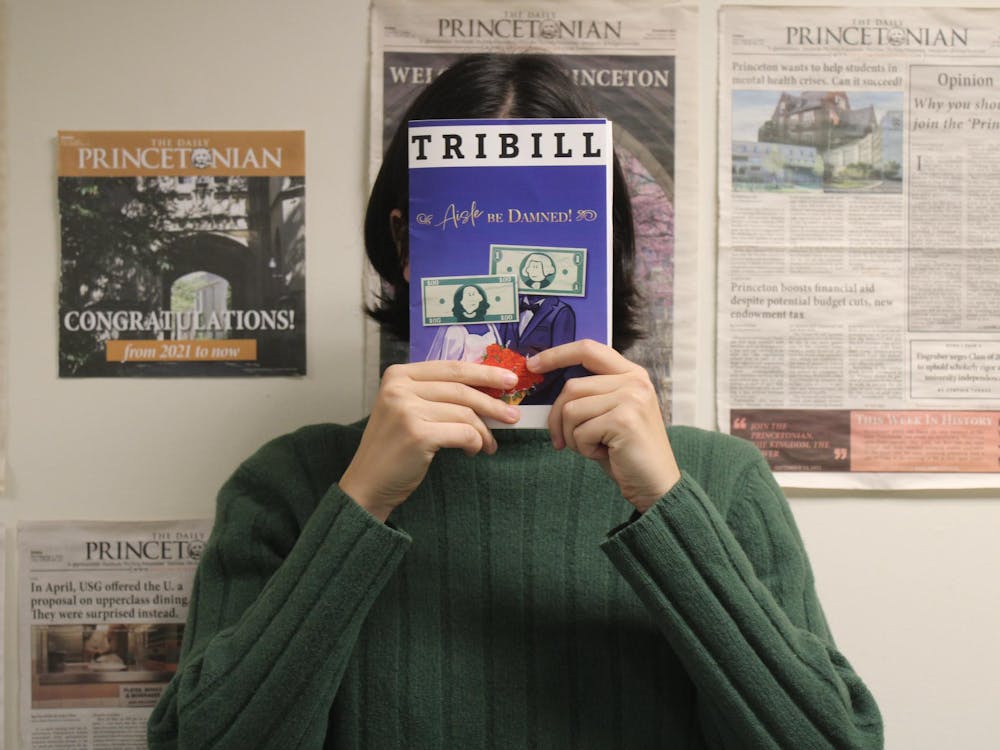It is a timeless classic of betrayal, of how one man’s noble dream deteriorated into a decaying corpse. It is a tale of loves lost and the fruitlessness of living in the past. It is Mary Shelley’s “Frankenstein,” adapted for the stage by Robert N. Sandberg ’70, a Princeton lecturer. Kanoa Mulling ’15 directs this play, which portrays the stark, chilling realities that confront the scientist Victor Frankenstein as he struggles to ameliorate the devastation wrought by his creation.
The set is decorated with icy blue panels, and a light screen of smoke fills the air, creating the illusion of being transported into the frigid lands of the Arctic Circle as soon as one steps through the door of the theater. The play, like the novel, opens on board Captain Walton’s ship near the North Pole. The fog, the humming sound of the ship’s engine, a mysterious figure wrapped in a sheet and the dim stage with cool blue hues complete the Gothic atmosphere, which is essential for any “Frankenstein” adaptation. Lighting designer Alana Jaskir ’17 imbues the stage in monochromatic hues at various points in the play, helping the audience distinguish among the different states of Frankenstein’s mind. In the icy present aboard Walton’s ship, the stage is awash with blue, while Frankenstein’s happy memories of his family are orange, and more sinister fantasies and memories turn into deep shades of red and purple. The entire set consists of the panels and two boxes, all painted blue. While the set pieces would be plain by themselves, the colors completely fill the stage and reflect off the actors when coupled with the dynamic lighting, elegantly completing each scene.
The actors take full advantage of the Gothic backdrop created by the stage crew. Ryan Gedrich ’16 plays the titular mad scientist with aplomb, alternating between Frankenstein’s moments of frenetic activity and depressed indolence. Pat Rounds ’15, once again proving his strong aptitude for playing angrily brooding characters who have a softer side, takes on the role of Frankenstein’s creature. He dominates the stage in his scenes, even when he is merely watching from the shadows, awaiting the right time to strike out at Frankenstein to take his revenge. His dire warning, “I shall be with you on your wedding night,” one of the most memorable lines from the novel, sends a chill shivering down one’s spine. Rounds’ performance is such that even when he is neither seen nor heard, Frankenstein’s creature’s presence can still be felt. It is small wonder then that Victor Frankenstein grows so feverish and nervous as he anticipates his final showdown with his creation.
Despite these strengths, one of the most crucial moments in the plot came as a slight disappointment. When Frankenstein brings his creature to life, as he revels in the climax of his life’s ambitions, he gazes upon the creature’s face and suddenly realizes that instead of embracing his creation, he hates what he has brought about.This turning point drives Frankenstein to reject his dream and fuels the creature’s thirst for vengeance. However, this moment did not hit the audience as hard as it should have. Frankenstein’s conversion did not feel convincing enough for the audience to believe that he had completely renounced and disowned his work. Audience members unfamiliar with the novel might even have expected an eventual reconciliation between the two.
Despite this, Theatre Intime’s “Frankenstein” is overall a great performance. Evelyn Giovine ’16 excellently portrays the sweetly charming Elizabeth, Frankenstein’s adopted sister and eventual wife, the only person who can comfort Frankenstein while he is in the depths of his despair. Caroline Hertz ’15 plays the macabre would-be bride of Frankenstein’s monster, which displaces Frankenstein’s deceased mother in his conscious, turning his dreams into nightmares. Lagan Trieschmann ’15 plays Captain Walton and Frankenstein’s former professor but shines as Frankenstein’s father, who seems to suffer to an even greater extent than Frankenstein himself. As eachnew wave of bad news crushes him, he grows frailer and frailer until he simply collapses.
The crew has paid very close attention to detail in the visuals and the sounds. All the characters dress in contemporary nineteenth-century clothing, including a distinguished-looking morning coat for Trieschmann’s characters and long skirts for the women. In later scenes, Frankenstein’s monster dresses in the same style as his “father,” even taking on the same type of waistcoat and cravat, to show that although they declare war against each other, they share an inseparable bond. The use of sound also works well in this play. A strong, steady heartbeat heralds the creature’s arrival, and the dull roar of Captain Walton’s icebreaking ship brings the audience out of Frankenstein’s mind and back to his present.
While some moments of this play were not perfect, as a whole it was an excellent show. Rounds’ and Trieschmann’s acting were superb, and the costumes (designed by Savannah Marquardt ’16) bring a tasteful elegance to each scene. The uses of sounds and colors heighten the mood of the play. Theatre Intime’s performance of Sandberg’s play brings new life to Shelley’s classic novel.
4.5 out of 5 paws
Pros: Costumes; color and sound; Rounds as Frankenstein’s creature.
Cons: Occasionally less than convincing scenes.








